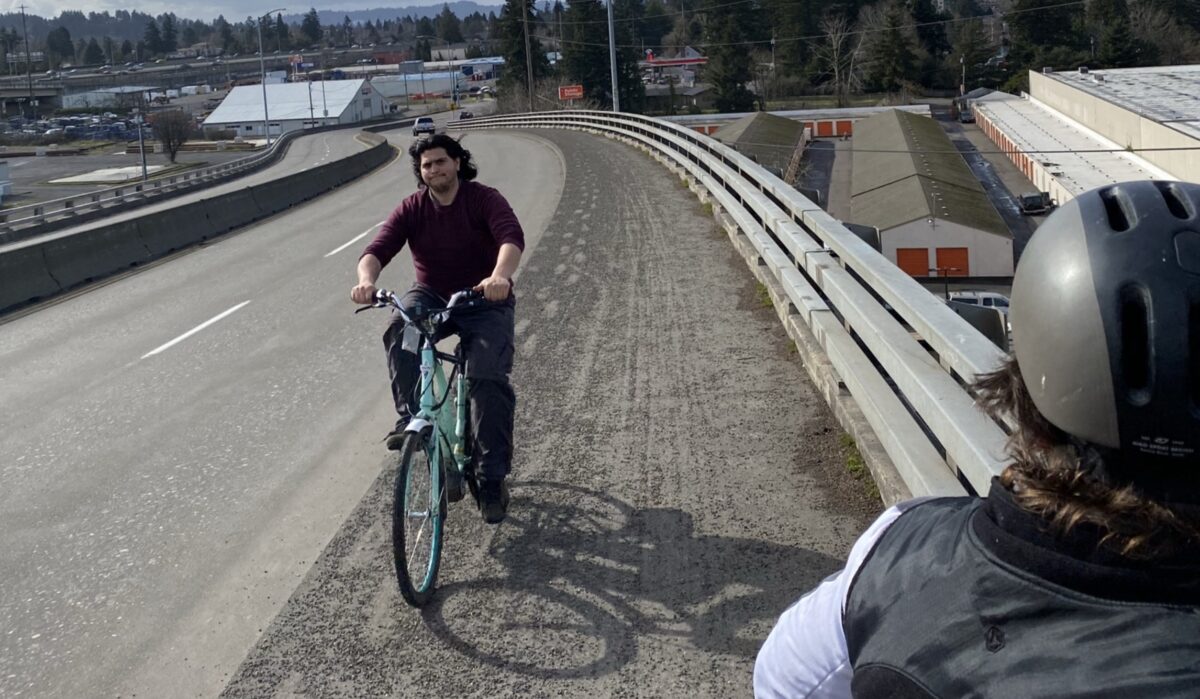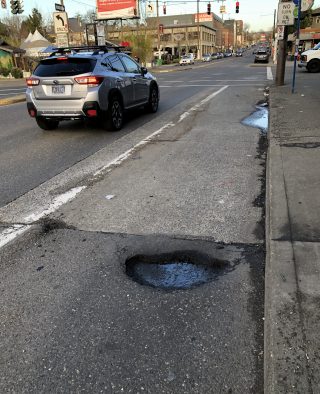
(Photo: Jonathan Maus/BikePortland)
It’s been 17 days since Portland experienced a major winter storm. For people who get around mostly by car, the storm was a relatively minor inconvenience. It was a few days of snow and ice and a bit of shoveling before things were back to normal.
But it’s a much different story for people who aren’t in a car.
For people who use bike lanes or shoulders on a bike, scooter, skateboard, roller-blades, or any type of wheeled mobility device, it’s been over two weeks since roads were free of hazardous debris. And let’s not forget that before the snow-then-slush-then-gravel, we had piles of leaves in fall, standing water after it rained, and the year-round presence of work zones and illegal parking and driving.
Taken separately, these hazards are often dismissed as minor inconveniences or yet another example of “those whiny entitled cyclists”. Together, they help explain why cycling is in decline in Portland. To be clear: These hazards make some people give up on active transportation altogether and get back in their cars.
Advertisement
For those who still choose to ride and roll, these dirty streets force them to accept yet another risk.
Portlander Julie Garner is an example of what happens when we don’t clean up this gravel quickly enough. Yesterday she was biking on SE Hawthorne at 12th when she crashed. It was severe enough that Garner received a concussion, cracked her helmet and doesn’t recall the incident. She posted to Twitter from her hospital bed that, “I was told I slipped on gravel (in bike lane).”
The day before Garner’s crash, we posted a video from the Northeast Halsey/I-205 overpass (below). Conditions there are bad even without gravel because bicycle riders and walkers in both directions are forced to share one standard sidewalk. With gravel, it’s extremely dangerous — especially as you start rolling downhill just feet away from people in cars.
Responses to both of these posts reveal widespread fear and frustration about the amount of gravel that still remains on key Portland bikeways. We’ve heard about dangerous conditions on streets like SW Terwilliger, bike lanes near Moda Center, N Interstate, Hawthorne Bridge viaduct, and so on. The problem has gotten worse with protected bike lanes where the presence of curbs and/or wants prevents plows and sweepers from getting all the way to the curb.
Advertisement
Portlander Leslie Carlson said she rode on Terwilliger from Chart House to Sheridan over the weekend: “The gravel was thick in the bike lane. We were forced to descend on to the road, which angered drivers behind us. I’m afraid somebody is gonna get really injured up there.”
Stay in the bike lane or shoulder and risk slips, falls, and flat tires; leave the bike lane and risk aggressive drivers.

(Photo: David Stein)

(Photo: Hami Rahmani)
What’s even more frustrating is that the Portland Bureau of Transportation has been aware of the problem for many years, yet it doesn’t feel like their response has gotten any better. Their crews were quick to lay down about 425 cubic yards of gravel to help people drive more safely; but the consequences of that move last for weeks and result in less safety for others.
“We understand that gravel in the roadway isn’t pleasant — many of us are people who bike too — and that is why we work as quickly as possible to pick it up.”
— John Brady, PBOT
Our coverage of the gravel-in-the-bike-lanes problem dates back to 2007. There are now 18 posts (including this one) in our “gravel in bike lanes” story archives. Each time we cover this issue, the response is the same: Just be patient. We’re doing our best.
PBOT says gravel recovery is “challenging because the City’s limited number of sweepers travel 2-3 mph and have 518 miles of streets to cover.” In response to concerns raised this weekend, PBOT encouraged people to report it via PDXReporter.org or create a maintenance ticket via 503-823-1700 or pdxroads@portlandoregon.gov.
Asked today whether or not they have a specific plan to keep key bikeways clean, and why the gravel continues to be a problem after all these years, PBOT spokesman John Brady said, “We understand that gravel in the roadway isn’t pleasant — many of us are people who bike too — and that is why we work as quickly as possible to pick it up.” “This year even as we were still plowing and treating the roads, we were already looking ahead and planning how we would work to get the gravel out of the bike lanes and the shoulders. Such planning is a central part of our approach to every winter weather event.”
In response to Garner’s post, Sarah Iannarone shared via Twitter that she feels the city’s response is “very unstrategic.” “The gravel ultimately causes more problems than it solves.”
Planning is nice. Action is better. We’ve been told for years to be patient and that PBOT is doing their best. Now we’re doing our best to remain patient.
— Jonathan Maus: (503) 706-8804, @jonathan_maus on Twitter and jonathan@bikeportland.org
— Get our headlines delivered to your inbox.
— Support this independent community media outlet with a one-time contribution or monthly subscription.




